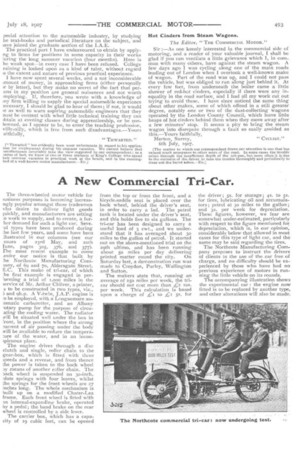A New Commercial Tri.Car.
Page 23

If you've noticed an error in this article please click here to report it so we can fix it.
The three-wheeled motor vehicle for lusiness purposes is becoming increasngly popular amongst those tradesmen vho desire to deliver light goods [uickly, and manufacturers are setting so work to supply, and to create, a furher demand for such a light car. Seve'al types have been produced during she last few years, and some have been .11ustrated in our columns (see our .ssues of 23rd May, and 20th lune, pages 305, 376, and 377). The most recent example to come mder our notice is that bunt by he Northcote Manufacturing Com)any, of 69 and 70, Aidersgate Street, E.C. This make of tri-car, of which :he first example is engaged in per'orming a trial of 1,000 miles in the iervice of Mr. Arthur Chilver, a printer, s to be constructed in two types, viz., 5 and 9h.p. A V-twin, J.A.P. engine is :o be employed, with a Longuernare
an:omatic carburetter, and an Albany -otary pump for the purpose of circuating the cooling water. The radiator will be situated well under the box in ront, in the position where the strong :.urrent of air passing under the body will be available to reduce the tempera:ure of the water, and in an inconpicuous place.
The engine drives through a disc clutch and single, roller chain to the gear-box, which is fitted with three ;Deeds and a reverse, and from thence the power is taken to the back wheel Dv means of another roller chain. The back wheel is suspended on 30-inch, plate springs with four leaves, whilst Lime springs for the front wheels are 27 inches long. The whole mechanism is built up on a modified Chater-Lea Frame. Each front wheel is fitted with an internal-expanding brake, operated by a pedal ; the band brake on the rear wheel is controlled by a side lever.
The carrier box, which has a capacity of 19 cubic feet, can be opened from the top or from the front, and a bicycle-saddle seat is placed over the back wheel, behind the driver's seat, in order to carry a lad. The petrol tank is located under the driver's seat, and this holds five to six gallons. The tri-car has been designed to carry a useful load of 3 cwt., and we understand that it has averaged about 30 miles to the gallon of petrol. It started out on the above-mentioned trial on the 29th ultimo, and has been running about 5o miles per day delivering printed matter round the city. On Saturday last, a demonstration run was made to Croydon, Purley, Wallington and Sutton.
The makers state that, running an average of 250 miles per week, the tricar should not cost more than Lo Josper week. This calculation is based upon a charge of 4-t to £i 5s. for
the driver ; 55. for storage; 45. to 5s. for tires, lubricating oil and accumulators; petrol at 30 miles to the gallon ; and 3s. per week for depreciation. These figures, however, we fear are somewhat under-estimated, particularly with respect to the figure mentioned for, depreciation, which is, in our opinion, considerably below that allowed in most cases for this type of light car, and the same may be said regarding the tires.
The Northcote Manufacturing Company proposes to instruct the drivers of clients in the use of the car free of charge, and no difficulty should be experienced by those who have had no previous experience of motors in running the little vehicle on its rounds.
The accompanying illustration shows the experimental car : the engine now fitted is to be replaced by another type, and other alterations will also be made.


























